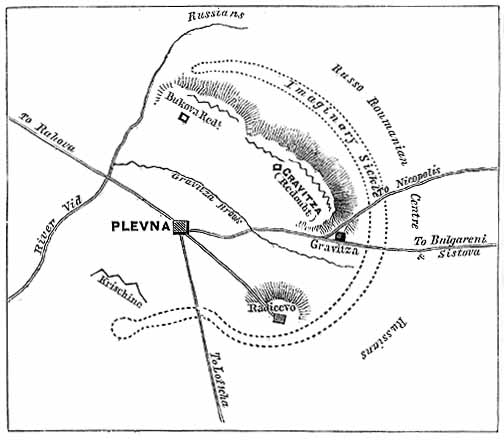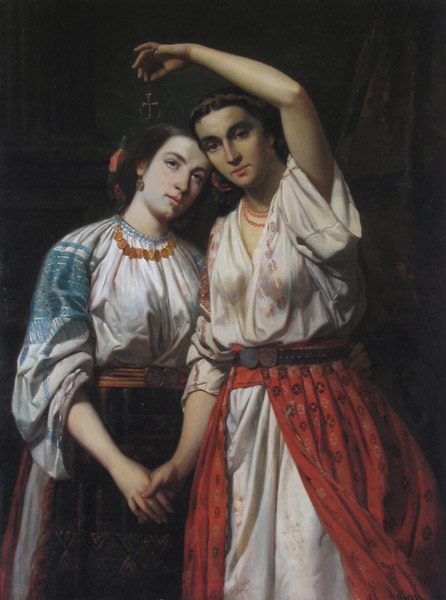|
Grivitsa
Grivitsa (, ; also transliterated as ''Grivitza'' or ''Grivica'') is a village in Pleven Municipality, Pleven Province, central northern Bulgaria. It is primarily known as the site of one of the key engagements in the Siege of Plevna during the Russo-Turkish War of 1877–1878. Geography Located 9 kilometres east of Pleven at an average 208 metres above sea level and lying in the hilly basin of the Vit River, Grivitsa has a population of 1,778 as of December 2009. The railway line connecting Sofia to Varna and Rousse runs through the village, as well as the main road from Pleven to Rousse, Nikopol and Pordim. The highest point of the Central Danubian Plain, the 304-metre-high ''Sredni vrah'' (, "Middle Peak") is just to the east of the village. The soil is rich in clay but suitable for agriculture. The area is also rich in limestone and quarries for its extraction have been built in several places. History The village's location has shifted several times, with the earli ... [...More Info...] [...Related Items...] OR: [Wikipedia] [Google] [Baidu] |
Siege Of Plevna
The siege of Plevna or Pleven, was a major battle of the Russo-Turkish War of 1877–1878, fought by the joint army of the Russian Empire and the Kingdom of Romania against the Ottoman Empire. After the Russian army crossed the Danube at Svishtov, it began advancing towards the centre of modern Bulgaria, with the aim of crossing the Balkan Mountains to Constantinople, avoiding the fortified Turkish fortresses on the Black Sea coast. The Ottoman army led by Osman Pasha, returning from Serbia after a conflict with that country, was massed in the fortified city of Pleven, a city surrounded by numerous redoubts, located at an important road intersection. After two unsuccessful assaults, in which he lost valuable troops, the commander of the Russian troops on the Balkan front, Grand Duke Nicholas of Russia insisted by telegram on the help of his Romanian ally King Carol I. King Carol I crossed the Danube with the Romanian Army and was placed in command of the Russian-Roman ... [...More Info...] [...Related Items...] OR: [Wikipedia] [Google] [Baidu] |
NMS Grivița
NMS ''Grivița'' was a gunboat of the Romanian Navy, built in 1880. It was the first warship acquired by the Kingdom of Romania after gaining independence in 1878 and the first military ship of the Romanian Black Sea Fleet. Throughout her career, she saw service on both the Black Sea and the Danube during the Second Balkan War and the First World War. Description ''Grivița'' was the first warship acquired by Romania after its 1877-1878 war of independence. She was built in 1880 by Stabilimento Tecnico Triestino in Austria-Hungary, being the last warship purchased by Romania before the country's conversion to a Kingdom in 1881. She measured 60.5 meters in length, with a beam of 5.2 meters and a draught of 1.8 meters. She displaced 110 tons standard and 128 tons with a full load of coal, had a crew of 30 men and a top speed of 9 knots, generated by a 180 hp steam engine. She was armed with two 57 mm Nordenfelt guns, two 37 mm 1-pounder guns and two machine guns. Career ''G ... [...More Info...] [...Related Items...] OR: [Wikipedia] [Google] [Baidu] |
Pleven Municipality
Pleven Municipality () is a municipality ('' obshtina'') in Pleven Province, Northern Bulgaria. It is named after its administrative centre - the city of Pleven which is also the capital of the Province. The municipality embraces a territory of with a population, as of December 2009, of 138,095 inhabitants. Settlements (towns are shown in bold): Demography The following table shows the change of the population during the last four decades. Religion According to the latest Bulgarian census of 2011, the religious composition, among those who answered the optional question on religious identification, was the following: See also *Provinces of Bulgaria *Municipalities of Bulgaria *List of cities and towns in Bulgaria This is a complete list of all cities and towns in Bulgaria sorted by population. Province capitals are shown in bold. Primary sources are the National Statistical Institute (NSI) and the Bulgarian Academy of Sciences. The largest city ... [...More Info...] [...Related Items...] OR: [Wikipedia] [Google] [Baidu] |
Ottoman Empire
The Ottoman Empire (), also called the Turkish Empire, was an empire, imperial realm that controlled much of Southeast Europe, West Asia, and North Africa from the 14th to early 20th centuries; it also controlled parts of southeastern Central Europe, between the early 16th and early 18th centuries. The empire emerged from a Anatolian beyliks, ''beylik'', or principality, founded in northwestern Anatolia in by the Turkoman (ethnonym), Turkoman tribal leader Osman I. His successors Ottoman wars in Europe, conquered much of Anatolia and expanded into the Balkans by the mid-14th century, transforming their petty kingdom into a transcontinental empire. The Ottomans ended the Byzantine Empire with the Fall of Constantinople, conquest of Constantinople in 1453 by Mehmed II. With its capital at History of Istanbul#Ottoman Empire, Constantinople (modern-day Istanbul) and control over a significant portion of the Mediterranean Basin, the Ottoman Empire was at the centre of interacti ... [...More Info...] [...Related Items...] OR: [Wikipedia] [Google] [Baidu] |
Ossuary
An ossuary is a chest, box, building, well, or site made to serve as the final resting place of human skeletal remains. They are frequently used where burial space is scarce. A body is first buried in a temporary grave, then after some years the skeletal remains are removed and placed in an ossuary ("os" is "bone" in Latin). The greatly reduced space taken up by an ossuary means that it is possible to store the remains of many more people in a single tomb than possible in coffins. The practice is sometimes known as grave recycling. Persian ossuaries In Persia, the Zoroastrianism, Zoroastrians used a deep well for this function from the earliest times (c. 3,000 years ago) and called it ''Tower of Silence, astudan'' (literally, "the place for the bones"). There are many rituals and regulations in the Zoroastrian faith concerning the ''astudans''. Jewish ossuaries During the Second Temple period, Jewish burial customs were varied, differing based on class and belief. For the wea ... [...More Info...] [...Related Items...] OR: [Wikipedia] [Google] [Baidu] |
Mausoleum
A mausoleum is an external free-standing building constructed as a monument enclosing the burial chamber of a deceased person or people. A mausoleum without the person's remains is called a cenotaph. A mausoleum may be considered a type of tomb, or the tomb may be considered to be within the mausoleum. Overview The word ''mausoleum'' (from the ) derives from the Mausoleum at Halicarnassus (near modern-day Bodrum in Turkey), the grave of King Mausolus, the Persian satrap of Caria, whose large tomb was one of the Seven Wonders of the Ancient World. Mausolea were historically, and still may be, large and impressive constructions for a deceased leader or other person of importance. However, smaller mausolea soon became popular with the gentry and nobility in many countries. In the Roman Empire, these were often in necropoles or along roadsides: the via Appia Antica retains the ruins of many private mausolea for kilometres outside Rome. When Christianity became domin ... [...More Info...] [...Related Items...] OR: [Wikipedia] [Google] [Baidu] |
United Principalities
The United Principalities of Moldavia and Wallachia (), commonly called United Principalities or Wallachia and Moldavia, was the personal union of the Moldavia, Principality of Moldavia and the Wallachia, Principality of Wallachia. The union was formed on when Alexandru Ioan Cuza was elected as the ''Domnitor'' (Ruling Prince) of both principalities. Their separate autonomous vassalage in the Ottoman Empire continued with Unification of Moldavia and Wallachia, the unification of both principalities. On , Moldavia and Wallachia formally united to create the Romanian United Principalities, the core of the Romanian nation state. In February 1866, Prince Cuza was forced to abdicate and go into exile by a political coalition led by the Liberals; the German prince Carol I of Romania, Karl of Hohenzollern-Sigmaringen was offered the Throne and, on he entered Bucharest for the first time. In July the same year, a 1866 Constitution of Romania, new constitution came into effect, giving th ... [...More Info...] [...Related Items...] OR: [Wikipedia] [Google] [Baidu] |
Russian Empire
The Russian Empire was an empire that spanned most of northern Eurasia from its establishment in November 1721 until the proclamation of the Russian Republic in September 1917. At its height in the late 19th century, it covered about , roughly one-sixth of the world's landmass, making it the list of largest empires, third-largest empire in history, behind only the British Empire, British and Mongol Empire, Mongol empires. It also Russian colonization of North America, colonized Alaska between 1799 and 1867. The empire's 1897 census, the only one it conducted, found a population of 125.6 million with considerable ethnic, linguistic, religious, and socioeconomic diversity. From the 10th to 17th centuries, the Russians had been ruled by a noble class known as the boyars, above whom was the tsar, an absolute monarch. The groundwork of the Russian Empire was laid by Ivan III (), who greatly expanded his domain, established a centralized Russian national state, and secured inde ... [...More Info...] [...Related Items...] OR: [Wikipedia] [Google] [Baidu] |
Redoubt
A redoubt (historically redout) is a Fortification, fort or fort system usually consisting of an enclosed defensive emplacement outside a larger fort, usually relying on Earthworks (engineering), earthworks, although some are constructed of stone or brick. It is meant to protect soldiers outside the main defensive line and can be a permanent structure or a hastily constructed temporary fortification. The word means "a place of retreat". Redoubts were a component of the military strategies of most European empires during the colonial era, especially in the outer works of Vauban-style fortresses made popular during the 17th century, although the concept of redoubts has existed since medieval times. A redoubt differs from a redan in that the redan is open in the rear, whereas the redoubt was considered an enclosed work. Historically important redoubts English Civil War During the English Civil War, redoubts were frequently built to protect older fortifications from the more effe ... [...More Info...] [...Related Items...] OR: [Wikipedia] [Google] [Baidu] |
Vakıf
A (; , plural ), also called a (, plural or ), or '' mortmain'' property, is an inalienable charitable endowment under Islamic law. It typically involves donating a building, plot of land or other assets for Muslim religious or charitable purposes with no intention of reclaiming the assets. A charitable trust may hold the donated assets. The person making such dedication is known as a ('donor') who uses a ''mutawalli'' ('trustee') to manage the property in exchange for a share of the revenues it generates. A waqf allows the state to provide social services in accordance with Islamic law while contributing to the preservation of cultural and historical sites. Although the system depended on several hadiths and presented elements similar to practices from pre-Islamic cultures, it seems that the specific full-fledged Islamic legal form of endowment called dates from the 9th century CE (see below). Terminology In Sunni jurisprudence, , also spelled (; plural , ; ) ... [...More Info...] [...Related Items...] OR: [Wikipedia] [Google] [Baidu] |






